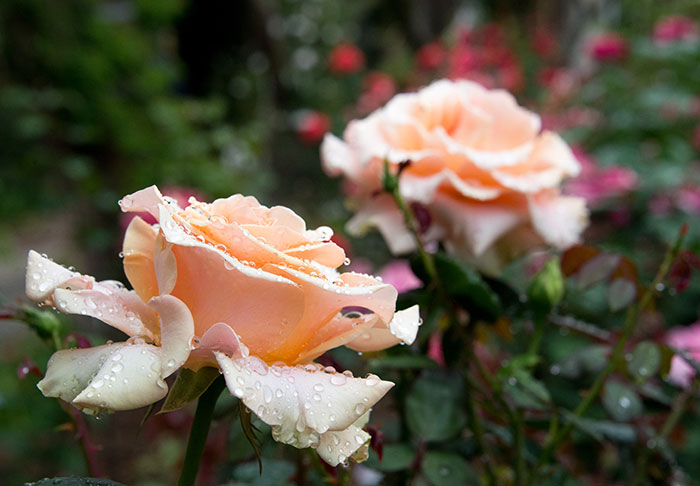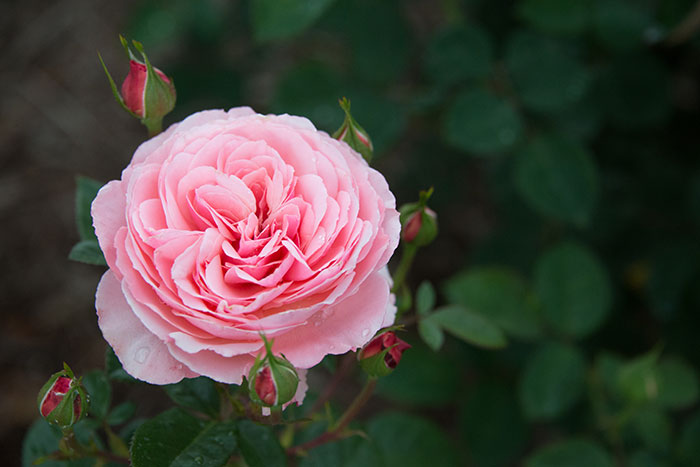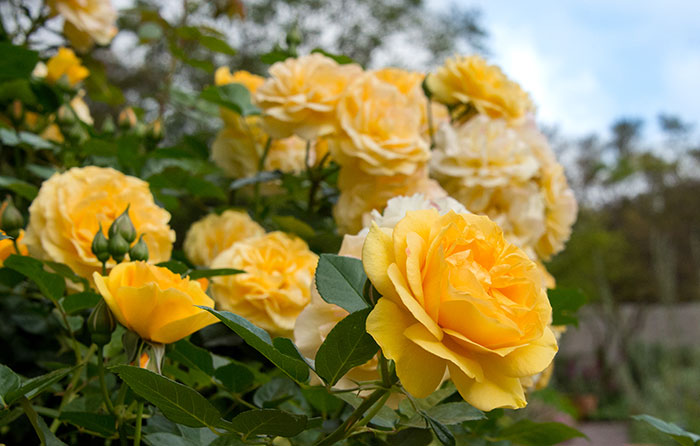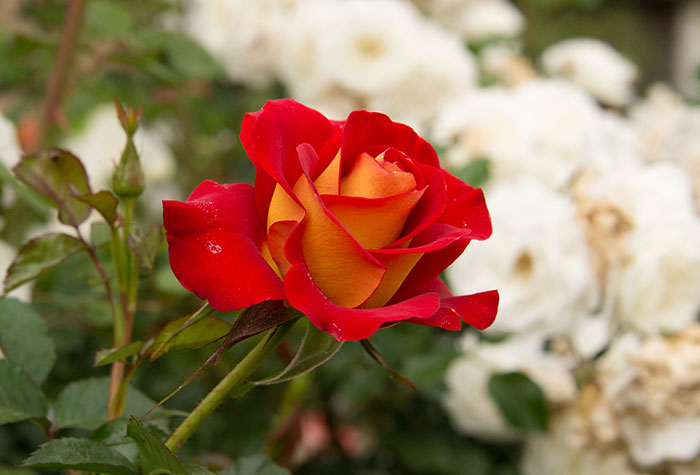The blog of The Huntington Library, Art Museum, and Botanical Gardens.
The Name of the Rose
Posted on Wed., May 2, 2018 by

‘Marilyn Monroe’ roses capture the freshness of a spring morning. Tom Carruth, The Huntington’s E.L. and Ruth B. Shannon Curator of the Rose Collections, named this creamy, long-limbed hybrid in 2002. Photo by Deborah Miller.
An old Hollywood crowd graces bed number 15 North in The Huntington’s Rose Garden. ‘Ronald Reagan’ and ‘Nancy Reagan’ naturally stand together, with ‘Ginger Rogers’ to one side, ‘Dick Clark’ on the other, and ‘Lucille Ball’ and ‘Cary Grant’ nearby.
Meanwhile, ‘Marilyn Monroe’ and ‘John F. Kennedy’ share their own quiet spot in bed number 23.
Tom Carruth, The Huntington’s E.L. and Ruth B. Shannon Curator of the Rose Collections, has been having fun grouping and pairing rose cultivars in the Rose Garden according to their names. Another inspiration led to his planting ‘Sexy Rexy’, a pink floribunda, one bed away from ‘Hanky Panky’, a striped floribunda.

‘Hanky Panky’, a striped floribunda, attracts attention in bed number 9 of the Rose Garden. Photo by Deborah Miller.
Carruth’s playful approach is a way for both the public and garden volunteers to navigate the three-acre Rose Garden, which showcases more than 1,200 cultivars and just over 2,500 individual shrubs.
An award-winning rose hybridizer who, over his long career, has introduced 142 rose cultivars and named many of these, Carruth clearly understands the importance of a rose’s name—one that somehow suits the cultivar’s personality, color, and fragrance. As it typically takes eight to 10 years to research, hybridize, and introduce a rose, a little name-dropping may be in order for its long-term life. (Attributing the qualities of a person to a rose seems a sure way to boost a flower’s appeal.)
“You want the name of a rose to be something that people easily remember,” Carruth says. “When you go to the store to buy it, if you can’t remember what it’s called—it wasn’t named right.”

Tom Carruth planted the captivating ‘Sexy Rexy’, a pink floribunda, in bed number 10—just one bed away from ‘Hanky Panky’. Photo by Deborah Miller.
Similarly, gardeners may not buy and plant roses with forgettable or unfamiliar names, which can lead to their demise because rose producers stop growing them.
A great name can help a mediocre rose, Carruth said, such as the ‘John F. Kennedy’, which he deemed an average white rose in need of more vigor, marked by a stingy bloom.
The ‘Marilyn Monroe’ rose, however, fully lives up to her appellation. Named by Carruth in 2002, this creamy, long-limbed hybrid has a platinum-blonde hue. Carruth gained the rights to Monroe’s name, he says, because the original director of the late actress’s estate had recently passed and his wife was happy to provide licensing rights for a one-time fee.

The ‘Julia Child’ rose, a floribunda that’s as golden-yellow as butter and has a sweet licorice fragrance, is named after the famous Pasadena-born chef. Photo by Deborah Miller.
Indeed, the person for whom a rose is named, or their estate, must give authorization. In the case of first ladies, for example, neither Hillary Clinton nor Michelle Obama have given authorization; Barbara Bush has had a rose named for her, and Nancy Reagan has had three. Hard to believe (and Carruth does not know why), but a rose has never been named for Jacqueline Kennedy Onassis.
Carruth has named roses for a number of celebrities, including ‘Julie Newmar’ and ‘Barbra Streisand’ (a 2001 hybrid tearose with rich lavender blooms and a citrusy fragrance that she chose herself).
But he’s most proud of his achievement with the ‘Julia Child’ rose, a floribunda that’s as golden-yellow as butter and has a sweet licorice fragrance. “It’s one of the top five of my career,” says Carruth. The All-American Rose Selection winner has seen considerable international success because it grows in a variety of climates.

This tastefully named rose is called ‘Ketchup and Mustard’. Photo by Deborah Miller.
Carruth had asked the American, Pasadena-born chef several times if he could name a rose for her, but she always said no. It was by happenstance that one day, in 2004, she visited a mutual friend, a Santa Barbara rose grower, who had one of Carruth’s new varieties in her garden. “When Child saw that rose, she said, ‘if there ever was a rose for which I would want to be named, this is it,’ so we jumped on it,” said Carruth.
After talking with Carruth and gaining an understanding of how roses are named, I walked through the Rose Garden thinking about the historical context or zeitgeist that must have influenced each chosen appellation: why is a rose variety named ‘Chrysler Imperial’ (1952), ‘Jiminy Cricket’ (1954), ‘City of Belfast’ (1968), ‘Apache Tears’ (1971), ‘Betty Boop’ (1999), or ‘Ketchup and Mustard’ (2012)?
Shakespeare famously wrote, “a rose / By any other name would smell as sweet,” but would it be as much fun to contemplate?
Manuela Gomez Rhine is a freelance journalist based in Pasadena, California.